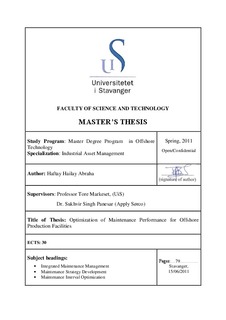| dc.description.abstract | New technologies are becoming advanced and complex for offshore production facilities. However this advancement and complexity in technology creates a more complicated and time consuming forensic processes for finding causes of failure, or diagnostic processes to identify events that reduce performance. As a result, micro-sensors, efficient signaling and communication technologies for collecting data efficiently, advanced software tools (such as fuzzy logic, neural networks, and simulation based optimization) have been developed, in parallel, to manage such complex assets. Given the nature and scale of ongoing changes on complexities, there are emerging concerns that increasing complexities, ill-defined interfaces, unforeseen events can easily lead to serious performance failures and major risks.
To avoid such undesirable circumstances, „just-in-time‟ measures of performance to ensure fully functional is absolutely necessary. The increasing trend in complexity creates a motivation to develop an integrated maintenance management framework to get real-time information to solve problems quickly and hence to increase functional performance (help the asset to perform its required function effectively and efficiently while safeguarding life and the environment). Establishing “just-in-time” maintenance and repairs based on true machine condition maximizes critical asset useful life and eliminates premature replacement of functional components.
This thesis focuses on developing an integrated maintenance management framework to establish „just-in-time‟ maintenance and to ensure continuous improvements based on maintenance domain experts as well as operational and historic data. To do this, true degradation of components must be identified. True level of degradation often cannot be inferred by the mere trending of condition indicator‟s level (CBM), because condition indicator levels are modulated under the influence of the diverse operating context. Besides, the maintenance domain expert does not have a precise knowledge about the correlation of the diverse operating context and level of degradation for a given level of condition indicator on specific equipment. Efforts have been made in here to identify the true degradation pattern of a component by analyzing these vagueness and imprecise knowledge.
Key words: effective and efficient maintenance strategy, ‘just-in-time’ maintenance, condition based maintenance, P-F interval. | no_NO |
